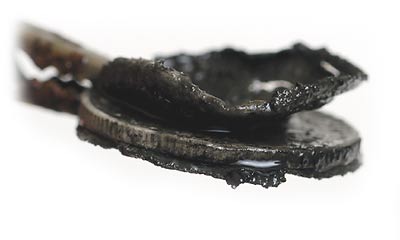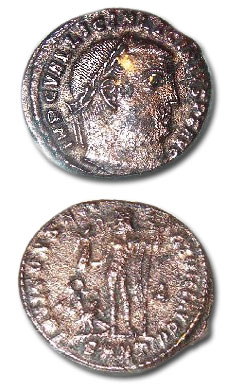Electrolysis to Clean Coins
Here's a closer view. To stop the reaction get some baking soda and while rinsing your coin under a faucet, use an old toothbrush and rub some of the baking soda on it. I usually use my fingers, which works good also, but the black will stain your fingers.
After cleaning this coin up I was surprised to see many details including the date on this Standing Liberty quarter.
 Hope you found this tutorial useful. We will try to write some more like this one in the near future, so stop by often!
Hope you found this tutorial useful. We will try to write some more like this one in the near future, so stop by often!
Others who dared to try : )
We do get a large amount of emails from folks about this tutorial. Some love it, others can't get it to work. This one email struck me as quite interesting, and I asked Mark if it was OK to post it here. I thought it would be a great addition to this page, so we can see how others are using electrolysis to their advantage.
From Mark Brophy
I just wanted to pass on a word of thanks to who ever wrote this article, your instructions for making a home based electrolysis set up was easy to follow and build.
I recently got back in to coin collecting, and while out antiquing with my wife I came across a bulk bag of ancient Roman coins so I bought them. I did clean some of the coins the old fashioned way by soaking them in various solutions and using polishes like "Peek" to do the rest.
 Cleaning ancient coins is a time consuming, pain staking effort - that I enjoy doing, however coupled with your electrolysis set up the coins come out much cleaned and with sharper original detail coming to life.
Cleaning ancient coins is a time consuming, pain staking effort - that I enjoy doing, however coupled with your electrolysis set up the coins come out much cleaned and with sharper original detail coming to life.
Please see two photo on the right, back and front of the first Roman coin I cleaned with your electrolysis set up - I am impressed.
These photos do not do this particular coin any justice, If you saw this in your hand, you would be as impressed as I with the final results.
It does not stop with the electrolysis, but a very good start.
Here are a couple of things I learned so far:
A) I use a 12 volt transformer, I fully intent to get one of higher voltage.
B) Depending on the size of glass, you may want to up the salt content to 2 teaspoons, or more.
C) What ever spoon you use for the positive pole, will eventually become useless as an eating utensil, the electrolysis process will damage the spoon over time.
D) Do not be shy with the lemon juice, 1 ounce to a glass of water seems to work fine.
E) I have found that 5 minutes is not quite enough time, I have had a single coin in electrolysis for up to an hour, with great results.
The only caution here is you need to watch the transformer carefully for the longer it runs the hotter it gets - real hot. For the people who claim your set up does not work, ask them to leave the coin or object in the electrolysis for 10 to 15 minutes, if the water has not changed color by then, or no bubbling is visible - then it is possible that what they are trying to clean does not have a metal alloy base.
Final Cleaning:
A) You will need some very fine steel wool #00, the type used to clean glass, this will help buff out any remaining dirt, build up off of the face, and it will not damage the coin in any way.
B) With a soft tooth brush, use a polish like "Peek", and apply with the brush, do not let dry but stand for a few seconds, then buff with a soft cloth. The alloys I have tested with your process so far, with success, would be Gold, Silver, Bronze & Copper. The photos here are of a Copper coin.
Mark Brophy
Bradford, Ontario, Canada
I'd like to say great job on your tutorial, but I felt like you might want to know something. The way electroysis works is by spilting molecules down to their seperate parts (anions and cations) and they then get attracted to the opposite charge. So for example, with water, the oxygen atoms would attract the the anion (cause oxygen is negatively charged) and hydrogen gas attracts to the cations (cause it is positively charged.) Thats how you can also remove rust from items attached to the cation, (rust is metal-oxide).
The reason I bring this up is because one of the steps calls for the use of a spoonful of salt so as to make the mixture an electrolyte. Salt, being Sodium-Chloride, would break down into harmless sodium, and not-so harmless chloride gas. Most electroysis hobbiests avoid the use of salt because it releases (albeit very slowly) chloride gas, which causes harm to anyone breathing it in. Most people will replace potentially dangerous Salt, with Baking Soda. Baking Soda breaks down into a much more safe mixture, and it works just as well.
Hi,
I am really enjoying your site. Lots of good down to earth ideas.
I think I know why some people have success with electrolysis and some do not. I have noticed that there are two kinds of wall modules out there. Some are AC and some are DC. I'm not sure why they do it, but some times they will use and AC module and put some diodes in the device they are charging to change the AC to DC inside the device.
An AC module will not work for electrolysis, only a DC module will work.
Hope this helps.
From Paul Andreasen:
Your tutorial is great! I am new to MDing, but old in electronics (years, too!) One improvement that would eliminate some safety concerns is getting a voltage source that also has a controlled current output. Current is what does the work, and when too much is "pulled" by the resistance of the circuit (your electrolysis setup), that is when the heat gets too high. The small wall warts have a limited amount of current they can supply, and something has to give. The heating is indicative of the small wire windings of the transformer inside carrying too much current for their size. They usually have NO circuitry to keep that under control. Even the so-called "regulated" supplies only try to regulate the voltage, not the current. It just runs away until something burns up, often the plastic housing will melt and cause a fire.
The small supplies (Chinese) found on ebay work well for this application, as you can adjust them to NOT provide beyond a set current, regardless of what the circuitry resistance does. The voltage output and the current capability are both adjustable, which provides longer life as well as a safer application. They are commonly available for $4-12, and I have used many of them for projects, as it is cheaper to buy them than to purchase even a fraction of the parts necessary to build one. One of the ebay suppliers I have used is
inksystems_xp. An example of the supply is item # 280742360867. Usually they do NOT have manuals or spec sheets, but searching for that on line gets what you need. I have ones for that item. Hopes this helps. Thanks for your efforts. Paul Andreasen Old_ROMAD on the Friendly Metal Detecting Forum
Just a couple of words to say that I am a metal detectorist from Greece since 1975 and also how much I enjoyed your tutorial about electrolysis.
However there are 2 things I would like to add:
1st thing: Instead of common salt, I use citric acid as electrolyte and the results are superior!
2nd thing: To overcome the overheating of the unit, in addition of a well ventillated room, I use a strong fan and direct the current straight on the unit. In this way your unit will last much longer, I dare to say, for tens of hundreds of cleanings!
Many Regards
Stephen Back to Page One